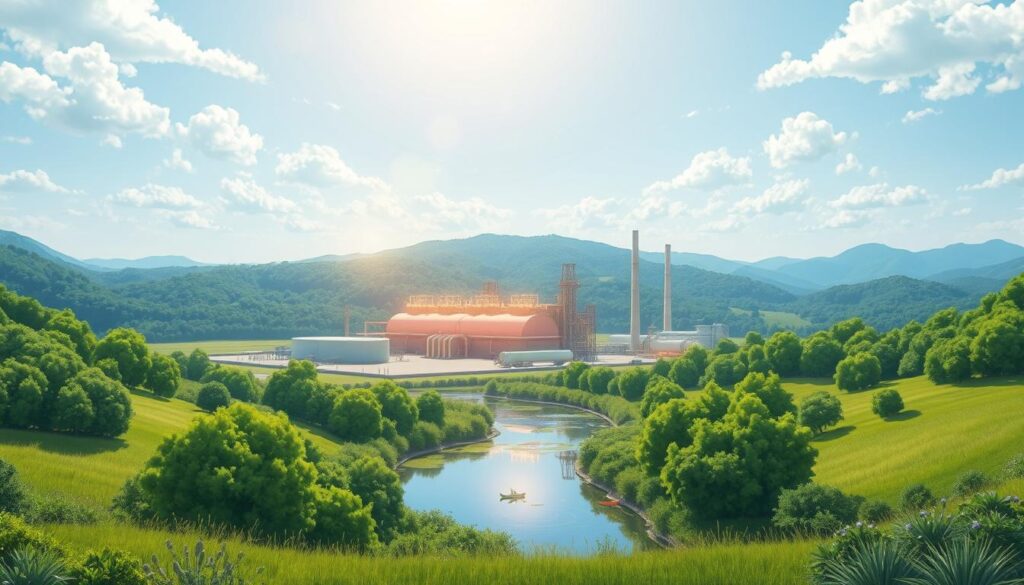The United States heavily depends on fossil fuels for energy. It’s important to look at the environmental effects of different fuels. We should also check out sustainable alternatives. Options like biodiesel, electricity, ethanol, and natural gas each have good and bad points for the environment.
Gasoline and diesel engines release pollutants like carbon dioxide, nitrogen oxides, and particulate matter. These pollutants harm the air and contribute to climate change. On the other hand, fuels like biofuels, electric vehicles, and natural gas vehicles can cut down on greenhouse gas emissions and make the air cleaner. But, the benefits of these fuels depend on how they are made and used.
Contents
Key Takeaways
- Fossil fuels like gasoline and diesel release harmful pollutants, contributing to air pollution and climate change.
- Alternative fuel options such as biofuels, electric vehicles, and natural gas have the potential to reduce greenhouse gas emissions and improve air quality.
- The environmental impact of alternative fuels can vary depending on factors like production, extraction, and lifecycle emissions.
- Transitioning to more sustainable fuel sources is crucial for the United States to reduce its reliance on non-renewable resources and mitigate the effects of climate change.
- Careful evaluation of the environmental pros and cons of different fuel types is necessary to determine the most environmentally friendly option.
Exploring Alternative Fuel Options
The world is looking for new fuel sources because traditional ones harm the environment. Biodiesel and electricity are now seen as good alternatives. They help reduce emissions and are more sustainable.
Biodiesel: A Renewable Fuel from Plant and Animal Sources
Biodiesel comes from plants and animals, like vegetable oils and animal fats. It’s better for the planet because it makes fewer greenhouse gases. It also has the same energy as regular diesel, so it works well in many vehicles.
Electricity: Powering Electric Vehicles for Zero Emissions
Electric vehicles (EVs) are changing how we think about car emissions. They use electricity and don’t pollute, making them a great choice for a cleaner future. EVs are perfect for people and companies wanting to lower their carbon footprint.
| Fuel Type | Greenhouse Gas Emissions | Energy Efficiency |
|---|---|---|
| Biodiesel | Substantially lower than traditional diesel | Comparable to conventional diesel |
| Electric Vehicles | Zero emissions during operation | Highly efficient, with the potential for further improvements |
Biodiesel and electric vehicles are key to a greener future. They help us use less carbon and make the planet healthier.
“The transition to alternative fuel sources is crucial for addressing the pressing environmental challenges we face. Biodiesel and electric vehicles are leading the charge in this transformation.”
Ethanol: America’s Homegrown Renewable Fuel
Ethanol is a renewable fuel made from corn and other plants. It’s mixed with gasoline for cars, cutting down on foreign oil use and helping the environment. Making ethanol from corn is key to America’s energy mix.
Production Process: From Corn to Alcohol
The ethanol journey starts with corn, grown in large amounts in the U.S. Iowa leads in ethanol production, making up nearly 30% of it. The corn’s starch is turned into alcohol through fermentation and distillation.
Environmental Benefits: Reduced Greenhouse Gas Emissions
Ethanol is better for the planet than traditional gasoline. It cuts greenhouse gas emissions by about 40-50%. This means using ethanol and biodiesel has reduced emissions like taking 30 million cars off the road.
Ethanol is key in fighting climate change. It aims to be net-zero carbon by 2050, making it a green energy choice. Its role in lowering carbon emissions is a big plus for a sustainable future.
| Key Ethanol Statistics | Data |
|---|---|
| Greenhouse Gas Emission Reduction | 40-50% compared to regular gasoline |
| Equivalent to Removing Cars from the Road | 30 million |
| Projected Net-Zero Carbon Emissions | Before 2050 |
| Ethanol Blended with Gasoline | About 10% in the United States |
| Ethanol Blended with Gasoline in Brazil | 20-25% |
“Ethanol contributes to economic benefits such as job creation, increased household income, and savings at the pump, making it a reliable and environmentally friendly energy alternative.”
Natural Gas: A Cleaner Fossil Fuel
The world is looking for ways to cut down on greenhouse gas emissions and fight climate change. Natural gas is seen as a cleaner fossil fuel option. It’s easy to get and cheaper than gasoline and diesel. But, its environmental perks compared to oil and coal are not as clear-cut.
Emission Comparison: Natural Gas vs. Oil and Coal
Natural gas is the cleanest fossil fuel when it comes to emissions from power plants. It has much lower levels of carbon dioxide, carbon monoxide, nitrogen oxides, sulfur dioxides, and particulates than oil and coal. This makes it a better choice for making electricity, helping to cut down on air pollution and greenhouse gases.
But, there are worries about methane leaks from natural gas pipelines and facilities. Methane, the main part of natural gas, is a strong greenhouse gas. It’s about 86 times more potent than CO2 in warming the planet over 20 years. Studies say the Environmental Protection Agency undercounts methane leaks from natural gas by 50 to 100%.
Using natural gas too much might slow down the switch to renewable energy sources. This could make it hard to meet the Paris Agreement’s goal of keeping global warming under 1.5°C above pre-industrial levels. Cutting down greenhouse gas emissions a lot is needed, and natural gas might not do enough on its own.

Natural gas is seen as a cleaner option than oil and coal, but methane leaks and the need for renewable energy must be considered. More research and policy changes are needed to understand and tackle the complex issues with using natural gas in fighting climate change.
Which fuel type is more environmentally friendly?
Choosing the most eco-friendly fuel isn’t easy. Each fuel type has its own good and bad points for the environment. We must look at greenhouse gas emissions, water use, habitat damage, and pollution.
Natural gas is cleaner than oil and coal, but it’s not perfect. Renewable fuels like biodiesel and ethanol cut down on emissions. Yet, making these fuels can also harm the environment.
Sustainable fuels could cut carbon emissions by over 80%, says the government. Biofuels might lower greenhouse gas emissions by up to 30% compared to fossil fuels. In the U.S., biofuels are used between 52% to 74% more than diesel and petrol. Soya oil and yellow grease are often used.
But, different biofuels come from various sources like corn, sugarcane, and algae. Each source affects the environment in its own way. We must think about these impacts.
There’s no single “best” fuel for the environment. Using a mix of renewable and sustainable fuels is a good idea. As we move to cleaner energy, comparing fuel types and their effects will help us find the best solutions.
“Biofuels serve as a low-carbon alternative to fossil fuels, promoting environmentally friendly practices in transportation and energy production.”
United States Energy Sources: Fossil Fuels and Beyond
The United States has always depended on fossil fuels for energy. But, with climate change becoming a big problem, we need to change. Using renewable energy like solar, wind, and hydropower is key for the US and Earth’s future.
Transition to Renewable Energy: The Need for Sustainable Solutions
Now, the US gets a lot of its energy from fossil fuels, with petroleum making up about 35% of its energy use. Even though we’re using less fuel now because of better technology and cleaner cars, we still have a lot to do. We need to cut down on carbon emissions and move towards sustainable energy.
- Coal and coal-fired power plants now account for less than a third of US electricity generation, down from over 50% in 2008.
- Natural gas, a cleaner fossil fuel, is now the biggest source of electricity, and it’s expected to play a bigger role in the US energy mix.
- Renewable energy sources, like solar and wind, are getting more popular, but they still don’t make up much of the US energy.
To switch to renewable energy, the US needs to make sustainable policies, invest in new tech, and get everyone to use clean energy. This is important for cutting down on fossil fuel use and reducing the harm to our environment.

“A sustainable energy future for the United States is not only possible, but necessary for the health of our planet and the wellbeing of future generations.”
Environmental Impacts of Coal
Coal mining and burning harm the environment in big ways. They pollute water by releasing chemicals like arsenic and lead. Coal mining also causes acid mine drainage, which adds heavy metals to water.
Water Pollution: A Persistent Challenge
Coal’s waste water is hard to control, causing ongoing pollution. This hurts both water life and human health. We need better rules and ways to clean up coal waste.
Acid Rain and Acid Mine Drainage
Burning coal also makes acid rain and acid mine drainage. These acids harm water and living things in it. Trying to fix this with technology hasn’t worked well, showing coal’s big environmental problems.
Mountaintop Removal: Habitat Destruction and Water Contamination
Coal mining, especially mountaintop removal, destroys homes and pollutes water. It clears forests and uses explosives to get coal. This ruins the environment and hurts local people. Coal mining is very bad for the planet, making it clear we should use cleaner energy sources.
Source Links
- https://www.maesmobility.be/en/blog/fuel/which-fuel-is-the-most-environmentally-friendly/ – Which fuel is the most environmentally friendly – MAES
- https://bumbleauto.com/blog/pros-and-cons-of-different-fuel-types – The Pros and Cons of Different Fuel Types | BumbleAuto
- https://apollo.engineer/alternative-fuels – Alternative Fuels | Exploring Alternative Fuel and Advanced Fuels for a Sustainable Future
- https://www2.deloitte.com/content/dam/Deloitte/in/Documents/energy-resources/in-eri-fuels-of-the-future-noexp.pdf – PDF
- https://afdc.energy.gov/fuels/emerging-hydrocarbon – Alternative Fuels Data Center: Renewable Gasoline
- https://www.iowafarmbureau.com/Article/Ethanol-vs-gasoline-Which-one-is-better-for-the-environment-and-the-US – Ethanol vs. gasoline: Which one is better for the environment and the U.S.?
- https://extension.psu.edu/fuel-ethanol-hero-or-villain – Fuel Ethanol: Hero or Villain?
- https://wtop.com/sponsored-content/2024/06/ethanol-brings-americas-clean-energy-future-within-reach/ – Ethanol brings America’s clean energy future within reach – WTOP News
- https://www.unep.org/news-and-stories/story/natural-gas-really-bridge-fuel-world-needs – Is natural gas really the bridge fuel the world needs?
- https://www.cleanwisconsin.org/under-the-lens-the-truth-about-natural-gas/ – Under the Lens: The Truth About Natural Gas
- https://sustain-fuels.com/education/sustainable-fuels/ – SUSTAINABLE FUELS | SUSTAIN Fuels
- https://unacademy.com/content/railway-exam/study-material/chemistry/which-fuel-is-considered-to-be-environmentally-friendly/ – WHICH FUEL IS CONSIDERED TO BE ENVIRONMENTALLY FRIENDLY?
- https://www.nationalgeographic.org/encyclopedia/fossil-fuels/ – Fossil Fuels
- https://www.nrdc.org/stories/fossil-fuels-dirty-facts – Fossil Fuels: The Dirty Facts
- https://www.igs.com/energy-resource-center/energy-101/what-makes-natural-gas-the-cleanest-fossil-fuel – What Makes Natural Gas the Cleanest Fossil Fuel? | IGS
- https://ballardbrief.byu.edu/issue-briefs/green-energy-usage-in-the-united-states – Green Energy Usage in the United States – Ballard Brief
- https://www.swarthmore.edu/environmental-studies-capstone/comparison-against-other-fossil-fuels – Comparison Against Other Fossil Fuels :: Environmental Studies Capstone :: Swarthmore College
- https://group.met.com/en/mind-the-fyouture/mindthefyouture/natural-gas-vs-coal – Natural gas vs Coal – environmental impacts
- https://www.eia.gov/energyexplained/coal/coal-and-the-environment.php – Coal and the environment – U.S. Energy Information Administration (EIA)

Hi, I’m Sufiyan, the developer behind this platform. I created FuelConsumptionCalculator.com to simplify fuel tracking for everyone — because understanding your vehicle shouldn’t require a degree in mechanics. I’m always working on adding more tools and content to make this site even more useful

